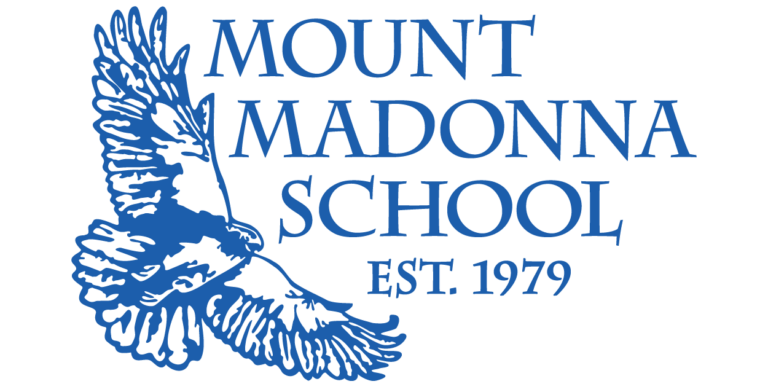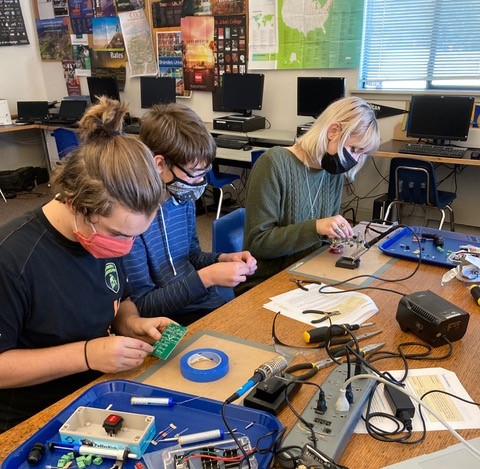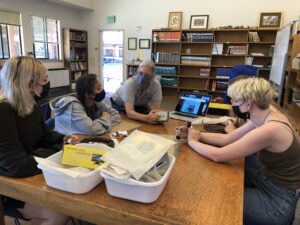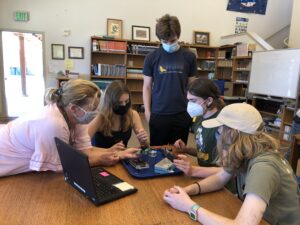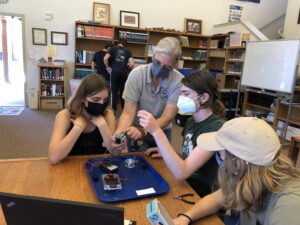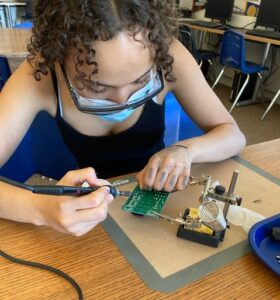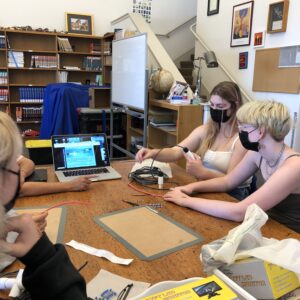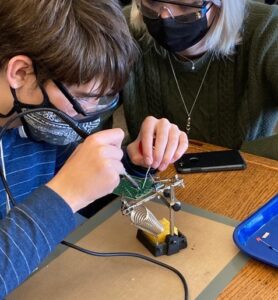 What does it take to design and build a submersible, water-tight instrument to explore the oceans?
What does it take to design and build a submersible, water-tight instrument to explore the oceans?
Last week, with their school trip to Catalina Island just 10 days away, Mount Madonna School (MMS) high school Engineering Club students gave up lunch periods, time before and after school and part of their weekend to help with constructing a pair of MATE ROVs (remotely operated vehicles). These camera-enabled, underwater robots will be used to explore the ocean channel off the island’s shores.
”MMS high school students applied their engineering and problem-solving skills to design and build an ROV for the Catalina Learning Journey,” commented Head of School Ann Goewert. “This hands-on project honed students’ technological skills by learning how to solder control boards, construct tethers and thrusters, wire and attach the motors, build a propulsion system, design waterproof boxes for cameras and build a PVC frame to support the ROV.”
 The Engineering Club is open to all MMS high school students, although at the moment it is mainly juniors and seniors who are preparing for the trip. Pre-pandemic, the school’s annual Catalina journey took place in the spring. The 2020 and 2021 trips were cancelled due to COVID-related restrictions for schools on overnight field trips. When those restrictions were lifted recently, MMS high school science teachers moved quickly to reschedule the trip for this fall, with plans to take all high school students, in addition to the freshmen and sophomore classes who usually attend.
The Engineering Club is open to all MMS high school students, although at the moment it is mainly juniors and seniors who are preparing for the trip. Pre-pandemic, the school’s annual Catalina journey took place in the spring. The 2020 and 2021 trips were cancelled due to COVID-related restrictions for schools on overnight field trips. When those restrictions were lifted recently, MMS high school science teachers moved quickly to reschedule the trip for this fall, with plans to take all high school students, in addition to the freshmen and sophomore classes who usually attend.
Guiding the students’ efforts is teacher Dr. Nicole Tervalon, who holds a Ph.D. in oceanographic engineering from the Massachusetts Institute of Technology and Woods Hole Oceanographic Institution Joint Program.
“Physical oceanography focuses on the physical and chemical properties of the ocean, including currents, tides and topography, and more directly the biological and engineering activities we engage the students in during our Catalina trip,” commented Tervalon. “The ocean has a major impact on all our lives. It significantly drives the world’s weather and climate, feeds a significant portion of the planet and impacts the large portion of the world’s population that lives in close proximity to it.
“Helping our students develop a respect and appreciation for the oceans’ power and ability to impact us, while also recognizing our impact on it, can produce the educated world citizens we need,” she continued. “Our students, through their explorations, science, and engineering activities in the beautiful Catalina environs, will begin, and in some cases continue, that journey.”
 Five days before their Catalina departure, 13 students working in collaborative teams gathered with Tervalon in the school’s library to continue the ROV build.
Five days before their Catalina departure, 13 students working in collaborative teams gathered with Tervalon in the school’s library to continue the ROV build.
“We are testing to make sure that all of the pieces are correctly soldered onto the motherboard,” said junior Sam Kaplan, who was helping classmate Cecily Kelly and senior Liana Kitchel to prepare components for the ROV control boxes.
Senior Blythe Wilson drew on her previous soldering experience to help build the tether assemblies for connecting the control boxes and motors. Wilson said she first learned to solder as an MMS middle school student working in the school’s Maker’s Lab and honed these skills junior year through the Engineering for Change class.
Each tether assembly includes multiple color-coded wires to prepare, connect and solder, and then finish with a heat gun to melt the solder and seal the connections, before threading each completed segment into a protective PVC housing.
At nearby table, meanwhile, six students worked on attaching a propeller to each of the six motors. Each ROV until is powered by three motor units.
“This part is no more difficult than building with Legos,” commented senior Addy Catterall-Pendleton, holding a completed motor and propeller unit in his hands.
“We’re using Loctite to keep the parts on there,” explained senior Ben Pearson. “It’s not a glue, but it will keep the pieces from unscrewing.”
 “I am kind of interested in knowing how they waterproofed the motor shafts,” commented junior Sandy Astone. “But I probably shouldn’t be taking it apart at this point to find out.”
“I am kind of interested in knowing how they waterproofed the motor shafts,” commented junior Sandy Astone. “But I probably shouldn’t be taking it apart at this point to find out.”
During their trip, students will use the newly-constructed ROVs to take less-intrusive data for longitudinal studies MMS has conducted at the remote end of Catalina for 10 years.
“This includes ethogram or behavior studies and field observation of the makeup of the ecosystems along the rocky intertidal shoreline and the inshore reef systems and kelp forests,” commented teacher and trip co-leader Lisa Catterall.
“In the past MMS students have done one-day ROV design challenges and piloted some professional ROVs owned by the Wrigley Center for Environmental Studies,” she continued. “What is very exciting about the school’s investment in this and other science platforms for the trip is that the students will have access to this advanced equipment for their entire stay and can use it as curiosity demands. In the schedule, students will have structured time to test and pilot the ROVs in Little Fisherman Cove, then will be able to return to using them at several different sites including the site of our longitudinal study.”
In their Catalina ethogram studies, MMS students typically observe and catalog behaviors among garibaldi, leopard sharks, Catalina gobies (who are very interesting in that they live in harems and change genders depending on dominance status), black bass, bat rays, Pacific octopus, and other diurnal kelp forest species. Using the camera-enabled ROVs may allow students to complete their ethogram studies with less disturbance to the animals they are looking at.
 During periods of remote learning in the previous school year, Honors Oceanography students conducted ethograms via the live feed of the captive kelp forest at the Monterey Bay Aquarium. They learned to identify the species and catalog typical behaviors. In addition, many of the senior students previously completed the MMS Engineering for Change elective, where they acquired skills such as soldering, needed for ROV construction.
During periods of remote learning in the previous school year, Honors Oceanography students conducted ethograms via the live feed of the captive kelp forest at the Monterey Bay Aquarium. They learned to identify the species and catalog typical behaviors. In addition, many of the senior students previously completed the MMS Engineering for Change elective, where they acquired skills such as soldering, needed for ROV construction.
For the past 10 years, pre-pandemic, tenth grade students visit the University of Southern California (USC) Wrigley Institute for Environmental Studies and the Wrigley Marine Science Center, to assist researchers with data collection and field studies. The MMS high school marine science program includes a marine biology lab elective in ninth grade as well. Ninth graders travel to another part of Catalina Island to become comfortable doing field science in and on the water, and to complete an environmental leadership program. Both of these classes are taken in addition to the traditional high school science sequence of biology, chemistry and physics. During these annual learning journeys, MMS students are working with the researchers there and co-developing and testing curriculum for their education initiatives for high school students.
For this fall 2021 learning journey, eleventh and twelfth grade students will be based at the Two Harbors campground, while ninth and tenth grade students will attend the Catalina Environmental Leadership Program at Howlands Landing on another part of the island.
###
Contact: Leigh Ann Clifton, director of marketing & communications,
Nestled among the redwoods on 375 acres, Mount Madonna School (MMS) is a diverse learning community dedicated to creative, intellectual, and ethical growth. MMS supports its students in becoming caring, self-aware, discerning and articulate individuals; and believe a fulfilling life includes personal accomplishments, meaningful relationships and service to society. The CAIS and WASC accredited program emphasizes academic excellence, creative self-expression and positive character development. Located on Summit Road between Gilroy and Watsonville. Founded in 1979.
